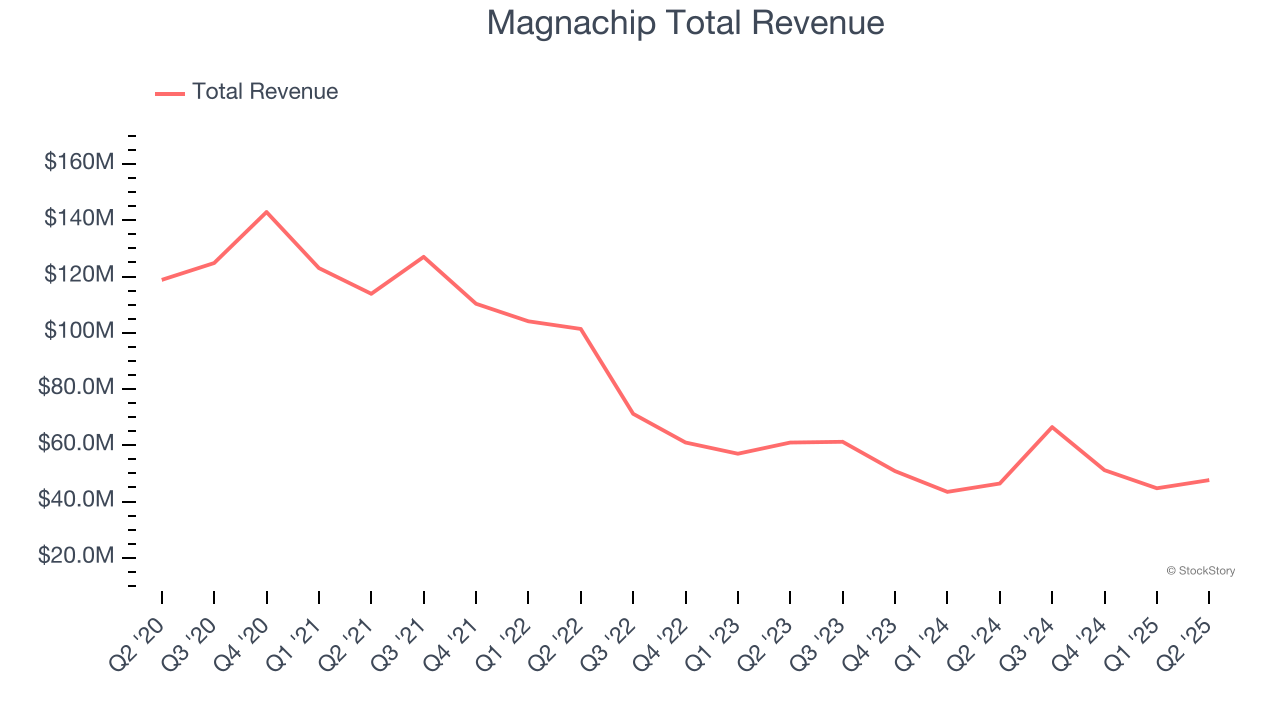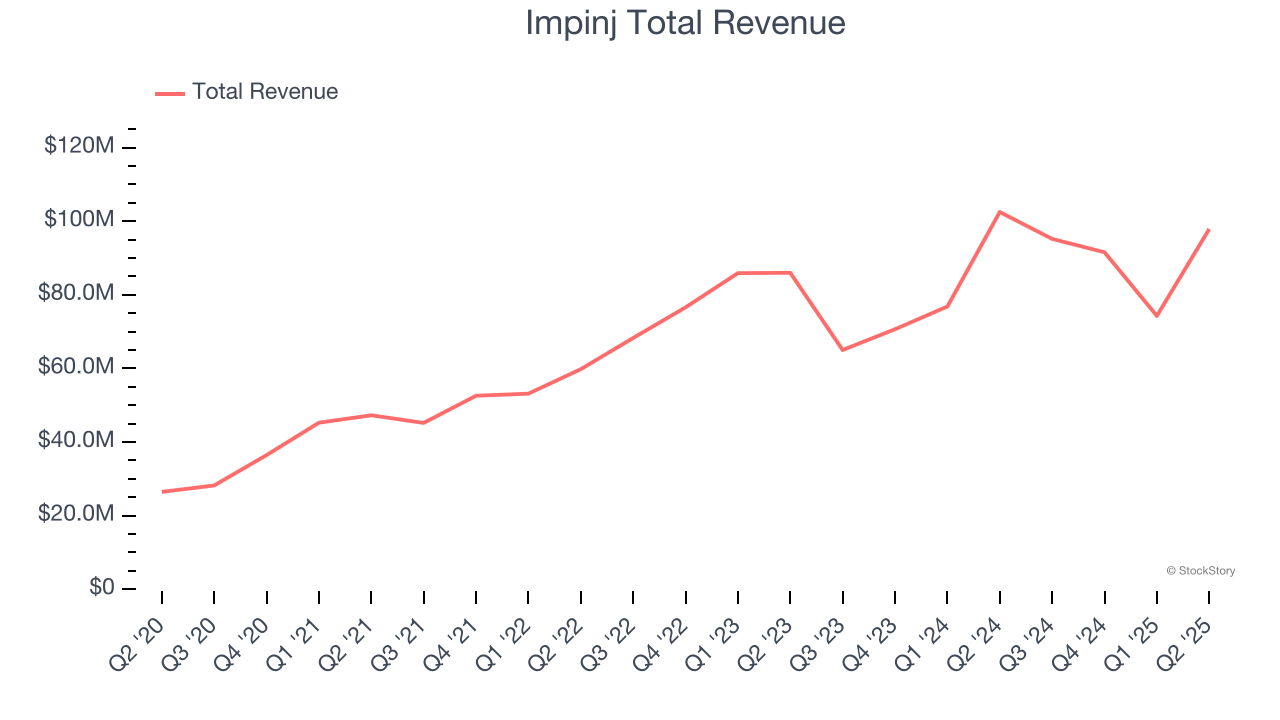![]()
Wrapping up Q2 earnings, we look at the numbers and key takeaways for the analog semiconductors stocks, including Magnachip (NYSE:MX) and its peers.
Demand for analog chips is generally linked to the overall level of economic growth, as analog chips serve as the building blocks of most electronic goods and equipment. Unlike digital chip designers, analog chip makers tend to produce the majority of their own chips, as analog chip production does not require expensive leading edge nodes. Less dependent on major secular growth drivers, analog product cycles are much longer, often 5-7 years.
The 15 analog semiconductors stocks we track reported a satisfactory Q2. As a group, revenues beat analysts’ consensus estimates by 2% while next quarter’s revenue guidance was in line.
In light of this news, share prices of the companies have held steady. On average, they are relatively unchanged since the latest earnings results.
Magnachip (NYSE:MX)
With its technology found in common consumer electronics such as TVs and smartphones, Magnachip Semiconductor (NYSE:MX) is a provider of analog and mixed-signal semiconductors.
Magnachip reported revenues of $47.62 million, up 2.6% year on year. This print exceeded analysts’ expectations by 0.9%. Overall, it was a satisfactory quarter for the company with a beat of analysts’ EPS estimates but an increase in its inventory levels.
Y.J. Kim, Magnachip’s CEO said, “In Q2, Magnachip delivered our fifth consecutive quarter of year-over-year revenue growth from continuing operations, driven primarily by strong performances in our communications and computing applications businesses. The quarter also benefited from some pull-in activity by customers, which contributed to the overall strength of the results. In industrial applications, we continued to see solid demand across key end markets, including e-motors, LED lighting, and 5G battery management systems.”

Unsurprisingly, the stock is down 22.8% since reporting and currently trades at $3.19.
Is now the time to buy Magnachip? Access our full analysis of the earnings results here, it’s free.
Best Q2: Impinj (NASDAQ:PI)
Founded by Caltech professor Carver Mead and one of his students Chris Diorio, Impinj (NASDAQ:PI) is a maker of radio-frequency identification (RFID) hardware and software.
Impinj reported revenues of $97.89 million, down 4.5% year on year, outperforming analysts’ expectations by 4.3%. The business had an exceptional quarter with a significant improvement in its inventory levels and a beat of analysts’ EPS estimates.

The market seems happy with the results as the stock is up 60% since reporting. It currently trades at $195.99.
Is now the time to buy Impinj? Access our full analysis of the earnings results here, it’s free.
Weakest Q2: Himax (NASDAQ:HIMX)
Taiwan-based Himax Technologies (NASDAQ:HIMX) is a leading manufacturer of display driver chips and timing controllers used in TVs, laptops, and mobile phones.
Himax reported revenues of $214.8 million, down 10.4% year on year, exceeding analysts’ expectations by 1.3%. Still, it was a softer quarter as it posted EPS in line with analysts’ estimates and an increase in its inventory levels.
As expected, the stock is down 5.3% since the results and currently trades at $8.18.
Read our full analysis of Himax’s results here.
Sensata Technologies (NYSE:ST)
Originally a temperature sensor control maker and a subsidiary of Texas Instruments for 60 years, Sensata Technology Holdings (NYSE: ST) is a leading supplier of analog sensors used in industrial and transportation applications, best known for its dominant position in the tire pressure monitoring systems in cars.
Sensata Technologies reported revenues of $943.4 million, down 8.9% year on year. This print beat analysts’ expectations by 1.1%. It was a strong quarter as it also produced a significant improvement in its inventory levels and a beat of analysts’ EPS estimates.
The stock is down 2.7% since reporting and currently trades at $31.66.
Read our full, actionable report on Sensata Technologies here, it’s free.
Texas Instruments (NASDAQ:TXN)
Headquartered in Dallas, Texas since the 1950s, Texas Instruments (NASDAQ:TXN) is the world’s largest producer of analog semiconductors.
Texas Instruments reported revenues of $4.45 billion, up 16.4% year on year. This number topped analysts’ expectations by 2%. Overall, it was a strong quarter as it also put up an impressive beat of analysts’ adjusted operating income and EPS estimates.
The stock is down 17.2% since reporting and currently trades at $177.82.
Read our full, actionable report on Texas Instruments here, it’s free.
Market Update
Thanks to the Fed’s rate hikes in 2022 and 2023, inflation has been on a steady path downward, easing back toward that 2% sweet spot. Fortunately (miraculously to some), all this tightening didn’t send the economy tumbling into a recession, so here we are, cautiously celebrating a soft landing. The cherry on top? Recent rate cuts (half a point in September 2024, a quarter in November) have propped up markets, especially after Trump’s November win lit a fire under major indices and sent them to all-time highs. However, there’s still plenty to ponder — tariffs, corporate tax cuts, and what 2025 might hold for the economy.
Want to invest in winners with rock-solid fundamentals? Check out our Top 6 Stocks and add them to your watchlist. These companies are poised for growth regardless of the political or macroeconomic climate.
StockStory is growing and hiring equity analyst and marketing roles. Are you a 0 to 1 builder passionate about the markets and AI? See the open roles here.
